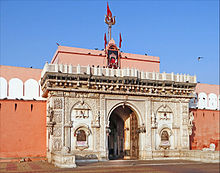Karni Mata Temple
| Karni Mata Temple | |
|---|---|
 Karni Mata Temple | |
 Location in Rajasthan, India Show map of Rajasthan  Karni Mata Temple (India) Show map of India | |
| Geography | |
| Coordinates | 27°47′26″N 73°20′27″E / 27.79056°N 73.34083°E / 27.79056; 73.34083Coordinates: 27°47′26″N 73°20′27″E / 27.79056°N 73.34083°E / 27.79056; 73.34083 |
| Country | India |
| State | Rajasthan |
| District | Bikaner |
| Location | Deshnoke |
| Culture | |
| Sanctum | Durga |
| Architecture | |
| Architecture | Rajput |
| History | |
| Date built | 15th - 20th century |
| Creator | Maharaja Ganga Singh |
Karni Mata Temple (Hindi: करणी माता मंदिर) is a Hindu temple dedicated to Karni Mata at Deshnoke, 30 km from Bikaner, in Rajasthan, India. It is also known as the Temple of Rats.
The temple is famous for the approximately 25,000 black rats that live, and are revered, in the temple. These holy rats are called kabbas, and many people travel great distances to pay their respects. The temple draws visitors from across the country for blessings, as well as curious tourists from around the world.[1]
Contents
1 The legend
2 Architecture
3 White rats
4 Worship and fair
4.1 Worship
4.2 Karni Mata Fair
5 Appearances in media
6 Photo gallery
7 See also
8 References
The legend
Legend has it that Laxman, son of Karni mata, drowned in a pond in Kapil Sarovar in Kolayat Tehsil while he was attempting to drink from it. Karni Mata implored Yama, the god of death, to revive him. First refusing, Yama eventually relented, permitting Laxman and all of Karni Mata's male children to be reincarnated as rats.[2]
Eating food that has been nibbled on by the rats is considered to be a "high honour".[3] If one of them is killed, it must be replaced with another one made of solid silver.
Architecture

Marble carvings at The Temple.
The building was completed in its current form in the early 20th century in the late Mughal style by Maharaja Ganga Singh of Bikaner.
In front of the temple is a beautiful marble facade, which has solid silver doors built by Maharaja Ganga Singh. Across the doorway are more silver doors with panels depicting the various legends of the Goddess. The image of the Goddess is enshrined in the inner sanctum.
White rats

White rat at the Karni Mata temple
Out of all of the thousands of rats in the temple, there are a few white rats, which are considered to be especially holy. They are believed to be the manifestations of Karni Mata herself and her four sons. Sighting them is a special blessing and visitors put in extensive efforts to bring them forth, offering prasad, a sweet holy food.
Worship and fair
Worship

Devotees performing the aarti at Karni Mata Temple.
The temple is opened to the public early in the morning at 04:00. Charan priests perform Mangla-Ki-Aarti and offer bhog (special food) in worship. Devotees make offerings to the rats, which roam about the temple in large numbers and are considered auspicious. There are two kinds of offerings made: the 'dwar-bhent' is attributed to the priests and the workers, while the 'kalash-bhent' is utilised for the temple maintenance and development.
Karni Mata Fair
Karni Mata Fair is held twice a year at Deshnok:
- The first and larger fair is held in March–April during the Navratras from Chaitra Shukla Ekam to Chaitra Shukla Dashmi.
- The second fair is held in September–October, also during the Navratras, from Ashvin Shukla to Ashwin Shukla Dashmi.
During Navratri thousands of people travel to the temple by foot.
Appearances in media
The temple appeared on the first season of the American reality television series The Amazing Race.[citation needed]
Because of its revered rat population, the temple was featured in the 2016 documentary film Rats, directed by Morgan Spurlock.[4]
Photo gallery
See also
- Karni Mata
References
^ Rats. Dir. Morgan Spurlock. Perf. Dr. Michael Blum, Ed Sheehan, Bobby Corrigan . Discovery Channel, 2016. Netflix. Chapter: Temple of the Rats
^ Deshnok – Kani Mata Temple India, by Joe Bindloss, Sarina Singh, James Bainbridge, Lindsay Brown, Mark Elliott, Stuart Butler. Published by Lonely Planet, 2007. .mw-parser-output cite.citation{font-style:inherit}.mw-parser-output q{quotes:"""""""'""'"}.mw-parser-output code.cs1-code{color:inherit;background:inherit;border:inherit;padding:inherit}.mw-parser-output .cs1-lock-free a{background:url("//upload.wikimedia.org/wikipedia/commons/thumb/6/65/Lock-green.svg/9px-Lock-green.svg.png")no-repeat;background-position:right .1em center}.mw-parser-output .cs1-lock-limited a,.mw-parser-output .cs1-lock-registration a{background:url("//upload.wikimedia.org/wikipedia/commons/thumb/d/d6/Lock-gray-alt-2.svg/9px-Lock-gray-alt-2.svg.png")no-repeat;background-position:right .1em center}.mw-parser-output .cs1-lock-subscription a{background:url("//upload.wikimedia.org/wikipedia/commons/thumb/a/aa/Lock-red-alt-2.svg/9px-Lock-red-alt-2.svg.png")no-repeat;background-position:right .1em center}.mw-parser-output .cs1-subscription,.mw-parser-output .cs1-registration{color:#555}.mw-parser-output .cs1-subscription span,.mw-parser-output .cs1-registration span{border-bottom:1px dotted;cursor:help}.mw-parser-output .cs1-hidden-error{display:none;font-size:100%}.mw-parser-output .cs1-visible-error{font-size:100%}.mw-parser-output .cs1-subscription,.mw-parser-output .cs1-registration,.mw-parser-output .cs1-format{font-size:95%}.mw-parser-output .cs1-kern-left,.mw-parser-output .cs1-kern-wl-left{padding-left:0.2em}.mw-parser-output .cs1-kern-right,.mw-parser-output .cs1-kern-wl-right{padding-right:0.2em}
ISBN 1-74104-308-5. Page 257.
^ Langton, Jerry (2007). Rat: How the World's Most Notorious Rodent Clawed Its Way to the Top. Macmillan. pp. 125–128. ISBN 0-312-36384-2.
^ Rebecca Hawkes (26 September 2016). "Rats: is Morgan Spurlock's new horror doc the most disgusting film of the year?". The Daily Telegraph. Retrieved 31 December 2016.
| Wikimedia Commons has media related to Karni Mata Temple. |








